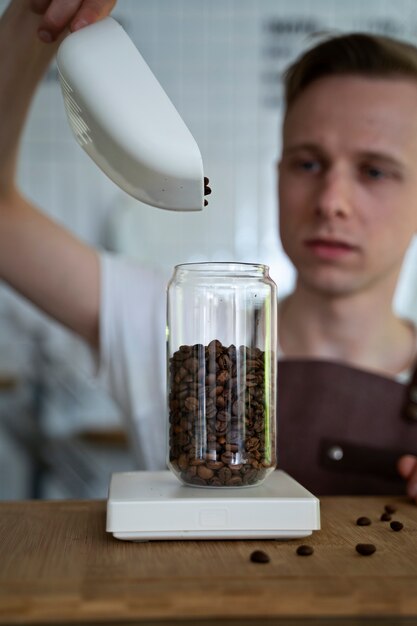Coffee is a beloved beverage, energising mornings and enhancing social gatherings. But what about those who love the flavour but want to avoid the buzz? That’s where caffeine-free options shine. Have you ever wondered how your favourite drink loses its stimulating element? The process is fascinating and meticulous.
What Does It Mean to Go Caffeine-Free?
These options, including decaf coffee beans, look and taste similar to their caffeinated counterparts but have most of the stimulating compound removed. On average, 97% of the caffeine is extracted, leaving a drink that still offers the rich aroma and delightful flavour many cherish. This makes it ideal for those who want to enjoy their daily brew without the potential jitters.
So, how does this transformation happen? Let’s explore the science behind the process.
How Is Caffeine Removed?
The transformation of regular coffee into this version is a precise blend of science, technique, and craftsmanship.
1. Solvent-Based Extraction
It is removed from raw materials using solvents like methylene chloride or ethyl acetate, which work alongside water to open the material’s pores. These solvents are highly effective at targeting caffeine molecules, enabling their extraction while safeguarding other compounds. Ethyl acetate, often derived from natural sources like fruit, is widely used due to its mild effect on flavour. Regulations ensure that any remaining traces of solvents meet stringent safety standards.
2. Swiss Water Process
This method is entirely chemical-free, relying on water and activated carbon to separate caffeine from the product. First, the raw materials are soaked in hot water to release their soluble components. The water, now rich in flavour and caffeine, is passed through a carbon filter, which traps the stimulant molecules. The flavourful liquid is then reintroduced to the product, maintaining its original character.
Known for its eco-friendliness, this method appeals to those who prioritise natural and sustainable production practices.
3. Carbon Dioxide (CO2) Process
The CO2 method utilises liquid carbon dioxide under high pressure to target and extract caffeine selectively. This technique preserves unique flavour characteristics, making it a preferred choice for high-quality caffeine-free products.
As one of the most advanced techniques, it ensures minimal flavour alteration and is highly efficient.
Does the Process Affect Flavour?
A common question among enthusiasts is whether removing caffeine impacts the flavour. Thanks to advancements in technology, the answer is reassuring. While there may be subtle differences, modern processes ensure the end result closely mimics the original product’s profile.
The choice of method and the raw material’s quality play a significant role in flavour retention. By selecting premium options, enthusiasts can enjoy a rich and satisfying experience that rivals traditional offerings.
Who Benefits from Choosing Caffeine-Free Options?
- Sensitive to Stimulants: For those who feel jittery or anxious after consuming caffeine, this alternative provides the same enjoyment without the side effects.
- Health Considerations: People managing conditions like acid reflux, high blood pressure, or insomnia may find a caffeine-free option more suitable.
- Nighttime Enjoyment: For anyone craving a warm, flavourful beverage in the evening, caffeine-free choices make for a perfect nightcap without disrupting sleep.
By offering all the perks of a favorite brew without the stimulant, these products are a versatile option for every lifestyle.
Exploring High-Quality Caffeine-Free Choices
For those who value taste and quality, selecting the right caffeine-free products can transform how they enjoy their favourite brews. By employing advanced decaffeination methods, premium options retain the authentic flavour that coffee lovers cherish, ensuring every cup is as enjoyable as its caffeinated counterpart.
From energising morning rituals to soothing evening indulgence, these thoughtfully crafted products cater to various preferences and routines. The meticulous attention to flavour and aroma makes them a trusted choice for anyone seeking a satisfying, caffeine-free alternative.
Tips for Choosing the Best Caffeine-Free Product
Finding the right caffeine-free option can be as rewarding as choosing a standard brew. Here’s how to make the best choice:
- Understand the Process: Products processed using methods like the Swiss Water Process or CO2 extraction are known for maintaining robust flavours.
- Focus on Origin: Single-origin varieties often carry distinctive flavour notes, even when caffeine-free.
- Know Your Roast Preference: Whether you love a light, medium, or dark roast, ensure the caffeine-free version aligns with your usual taste.
The Evolving World of Caffeine-Free Options
As demand grows, producers are innovating to improve caffeine-free alternatives, with sustainable practices like water-based decaffeination gaining popularity. With advanced methods and greater accessibility, enjoying a flavourful, eco-conscious brew tailored to any lifestyle has never been easier.
The journey of decaffeination is a remarkable blend of science and artistry, allowing decaf coffee beans to offer the same rich flavours and comforting experiences as traditional brews. Whether for health reasons, sensitivity to stimulants, or simply enjoying a warm cup at night, these options provide a versatile and satisfying choice for all. With evolving methods and a commitment to quality, caffeine-free beverages ensure that everyone can enjoy the pleasures of a great brew anytime.
Keep an eye for more news & updates on Gossips!




